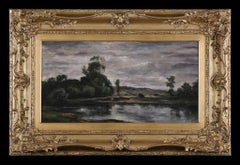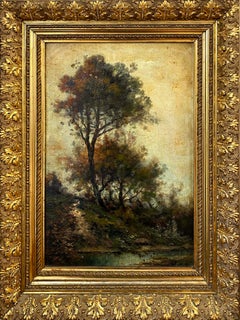Karl Daubigny Art
to
1
1
1
1
Overall Height
to
Overall Width
to
1
1
1
6,886
3,209
2,514
1,217
1
1
Artist: Karl Daubigny
A River Landscape
By Karl Daubigny
Located in St. Albans, GB
Karl Pierre DAUBIGNY
With price reaching upwards of $36 000 this is opportunity to purchase a piece by an artist who was at the forefront of the impressionist movement at a price that has great potential investment. It has excellent provenance coming from the continent via Christies in the 1980s and is in many important museums from the
Musée d’Orsay, Paris to the Rijksmuseum, The Hague.
Oil on panel
Panel size: 11 x 21" (28 x 54cm)
Outside frame size: (48 x 74cm)
Born on 19 June 1846 in Paris and died on 25 May 1886
Painter of animals, landscapes, marines in both oil and watercolours
Karl Pierre Daubigny was the son of, Charles Francois Daubigny, one of the original eight Barbizon painters and one of the leading landscapists of his time. Taught by his father, who greatly influenced him, Karl Daubigny travelled the French countryside painting...
Category
1860s Barbizon School Karl Daubigny Art
Materials
Oil
Related Items
Antique Barbizon School Oil Painting Original Gold Frame Rich Colors Fall
Located in Buffalo, NY
Original Barbizon school painting in an original period frame.
Framed 24 x 18
Unframed 18 x 12
Category
19th Century Barbizon School Karl Daubigny Art
Materials
Oil, Canvas
French Barbizon School oil painting, Sunset over a river landscape impressionist
Located in Antwerp, BE
Large French Barbizon riverscape "Sunset over a river" by Henry Jacques Delpy
This peaceful barbizon riverscape depicts a sunset illuminating the sky and covering the whole scenery ...
Category
19th Century Barbizon School Karl Daubigny Art
Materials
Canvas, Oil
The Forest, Large Barbizon School, Oil on Canvas Wooded Landscape
By Emile Roux-Fabre
Located in Cotignac, FR
A French Barbizon School oil on canvas forest view by Emile Roux-Fabre. The painting is signed and dated bottom left with a dedication.
A charming view of forest glade leading out to a valley landscape beyond. The artist has captured the magic feeling of the cool forest shade against the sunshine of the landscape beyond. The texture of the bark on the silver birch trees, the contrast of the leaves on the trees all framing the perspective to the view beyond. An extremely accomplished and atmospheric painting.
The Barbizon school of painters was part of an art movement towards Realism in art, which arose in the context of the dominant Romantic Movement of the time. The Barbizon school was active roughly from 1830 through 1870. It takes its name from the village of Barbizon, France, on the edge of the Forest of Fontainebleau, where many of the artists gathered. Most of their works were landscape paintings, but several of them also painted landscapes with farmworkers, and genre scenes of village life. Some of the most prominent features of this school are its tonal qualities, colour, loose brushwork, and softness of form.
The leaders of the Barbizon school were: Théodore Rousseau, Charles-François Daubigny, Jules Dupré, Constant Troyon, Charles Jacque, and Narcisse Virgilio Díaz. Jean-François Millet lived in Barbizon from 1849, but his interest in figures with a landscape backdrop sets him rather apart from the others. Jean-Baptiste-Camille Corot was the earliest on the scene, first painting in the forest in 1829, but his work has a poetic and literary quality which sets him somewhat apart. Other artists associated with the school, often pupils of the main group, include: Henri Harpignies, Albert Charpin, François-Louis Français and Émile van Marcke.
In 1824 the Salon de Paris exhibited works of John Constable, an English painter. His rural scenes influenced some of the younger artists of the time, moving them to abandon formalism and to draw inspiration directly from nature. Natural scenes became the subjects of their paintings rather than mere backdrops to dramatic events. During the Revolutions of 1848 artists gathered at Barbizon to follow Constable's ideas, making nature the subject of their paintings. The French landscape became a major theme of the Barbizon painters.
Millet extended the idea from landscape to figures — peasant figures, scenes of peasant life, and work in the fields. In The Gleaners (1857), for example, Millet portrays three peasant women working at the harvest. Gleaners are poor people who are permitted to gather the remains after the owners of the field complete the main harvest. The owners (portrayed as wealthy) and their laborers are seen in the back of the painting. Millet shifted the focus and the subject matter from the rich and prominent to those at the bottom of the social ladders. To emphasize their anonymity and marginalized position, he hid their faces. The women's bowed bodies represent their everyday hard work.
In the spring of 1829, Jean-Baptiste-Camille Corot came to Barbizon to paint in the Forest of Fontainebleau, he had first painted in the forest at Chailly in 1822. He returned to Barbizon in the autumn of 1830 and in the summer of 1831, where he made drawings and oil studies, from which he made a painting intended for the Salon of 1830; "View of the Forest of Fontainebleau'" (now in the National Gallery in Washington) and, for the salon of 1831, another "View of the Forest of Fontainebleau"'. While there he met the members of the Barbizon school: Théodore Rousseau, Paul Huet, Constant Troyon, Jean-François Millet, and the young Charles-François Daubigny.
During the late 1860s, the Barbizon painters attracted the attention of a younger generation of French artists studying in Paris. Several of those artists visited Fontainebleau Forest to paint the landscape, including Claude Monet, Pierre-Auguste Renoir, Alfred Sisley and Frédéric Bazille. In the 1870s those artists, among others, developed the art movement called Impressionism and practiced 'plein air' painting. In contrast, the main members of the school made drawings and sketches on the spot, but painted back in their studios.
The Post-Impressionist painter Vincent Van Gogh studied and copied several of the Barbizon painters as well, including 21 copies of paintings by Millet. He copied Millet more than any other artist. He also did three paintings in Daubigny's Garden.
The Barbizon painters also had a profound impact on landscape painting in the United States. This included the development of the American Barbizon school by William Morris Hunt. Several artists who were also in, or contemporary to, the Hudson River School studied Barbizon paintings for their loose brushwork and emotional impact. A notable example is George Inness, who sought to emulate the works of Rousseau. Paintings from the Barbizon school also influenced landscape painting in California. The artist Percy Gray...
Category
Early 20th Century Barbizon School Karl Daubigny Art
Materials
Canvas, Oil
H 24.02 in W 20.08 in D 0.79 in
Sunset, an emblematic painting by Théodore Rousseau inspired by Barbizon
By Théodore Rousseau
Located in PARIS, FR
While an exhibition is currently celebrating the work of Théodore Rousseau at the Petit-Palais in Paris, we are delighted to present this work, which is entirely emblematic of his ar...
Category
Mid-19th Century Barbizon School Karl Daubigny Art
Materials
Mahogany, Oil
French School 19th century, Animated dune landscape, oil on panel
Located in Paris, FR
French School mid 19th Century
Animated dune landscape,
oil on cardboard panel
12.4 x 29.8 cm
bears a small inscription "Escoublac" on the lower right, not visible under the actual ...
Category
1850s Barbizon School Karl Daubigny Art
Materials
Oil
Spanish school landscape with river oil painting Spain
Located in Barcelona, Barcelona
Oil on canvas glued to board.
Oil measures 25x40 cm.
Frameless.
Illegible signature.
Category
1920s Barbizon School Karl Daubigny Art
Materials
Canvas, Oil, Board
Antique Oil on Canvas Painting "Dancing Nymphs" Mythological Landscape Scene
Located in Firenze, IT
A luxuriant forest is the romantic and lyrical landscape where the dance of the nude nymphs takes place in this joyful 19th Century antique oil on canvas painting featuring a mythological scene.
Dance of the Nymphs and Naiads is a myth inspired by the tales of ancient Greece and ancient Rome, a subject already much loved in the Renaissance period as an allegory of rebirth - as in one of the most famous paintings in the world the Spring by Sandro Botticelli- then reproduced throughout the neoclassicism by academic painters -due to the renewed interest in classical artworks following the discovery of archaeological sites- and taken up later, with ecological purposes and meanings, also by the Barbizon school and Impressionist artists.
The present artwork – signed Vagner low left and datable to the second half of the 19th century - is closely inspired by an important work by the great Camille Corot, which is now housed at the Musée d'Orsay (Paris).
This historical oil on canvas painting, featuring a joyful scene with the three graces and other dancing nymphs...
Category
19th Century Barbizon School Karl Daubigny Art
Materials
Canvas, Oil
H 22.84 in W 30.71 in D 1.58 in
"Pont d'Espagne, Pyrenees", 19th Century Oil on Canvas by Théodore Richard
Located in Madrid, ES
THÉODORE RICHARD
French, 1782 - 1859
PONT D'ESPAGNE, PYRENEES
signed and dated "T. Richard / 1850" (lower left)
titled, located and dated "Pont d'Espagne / Pyrenees / 1850" (on the r...
Category
1850s Barbizon School Karl Daubigny Art
Materials
Canvas, Oil
19th century French Barbizon School Painting oil on Canvas Landscape circa 1840
Located in Portland, OR
19th century French Barbizon School Painting, oil on canvas signed "Marin", Circa 1840. A very attractive bucolic, pastoral landsacpe scene with sheep grazing on the banks of a lake ...
Category
Early 19th Century Barbizon School Karl Daubigny Art
Materials
Canvas, Oil
H 19.5 in W 24 in D 3 in
Laundresses on River 19th century Barbizonian Landscape by French Master
Located in Stockholm, SE
Signed lower right "C. Daubigny". As we gaze upon the painting, we are immediately drawn to the foreground, where a small group of women are diligently washing clothes on the banks o...
Category
Mid-19th Century Barbizon School Karl Daubigny Art
Materials
Canvas, Wood, Cotton Canvas, Oil
Charles Montlevault (1835-1897) Walkers along a cliff, oil painting signed
Located in Paris, FR
Charles Montlevault (1835-1897)
Walkers along a cliff
Signed lower left
Oil on canvas
35 x 27 cm
in good condition
In a vintage frame : 57.5 x 50 cm
unfortunately damaged with impor...
Category
1870s Barbizon School Karl Daubigny Art
Materials
Oil
Le Puits, The Water Well Amidst Romantic Ruins
Located in Cotignac, FR
Oil on board view of a water well set amidst romantic ruins and foliage with a figure, by L Masson. Signed bottom left presented in wood frame. There is a c...
Category
Mid-20th Century Barbizon School Karl Daubigny Art
Materials
Oil, Board
Karl Daubigny art for sale on 1stDibs.
Find a wide variety of authentic Karl Daubigny art available for sale on 1stDibs. You can also browse by medium to find art by Karl Daubigny in oil paint, paint and more. Not every interior allows for large Karl Daubigny art, so small editions measuring 29 inches across are available. Karl Daubigny art prices can differ depending upon medium, time period and other attributes. On 1stDibs, the price for these items starts at $7,022 and tops out at $7,022, while the average work can sell for $7,022.


